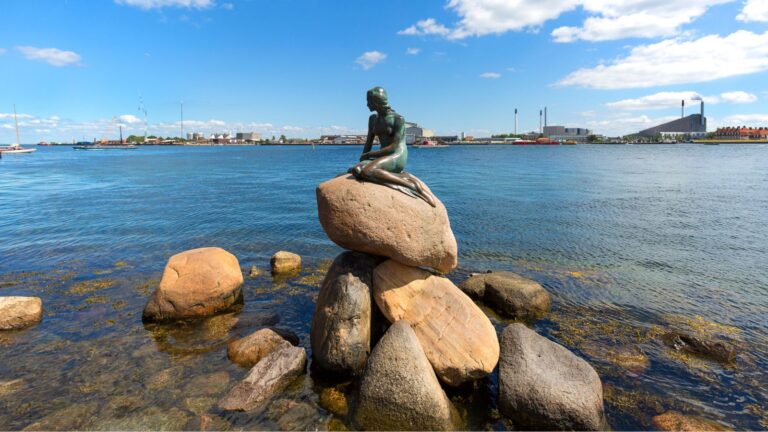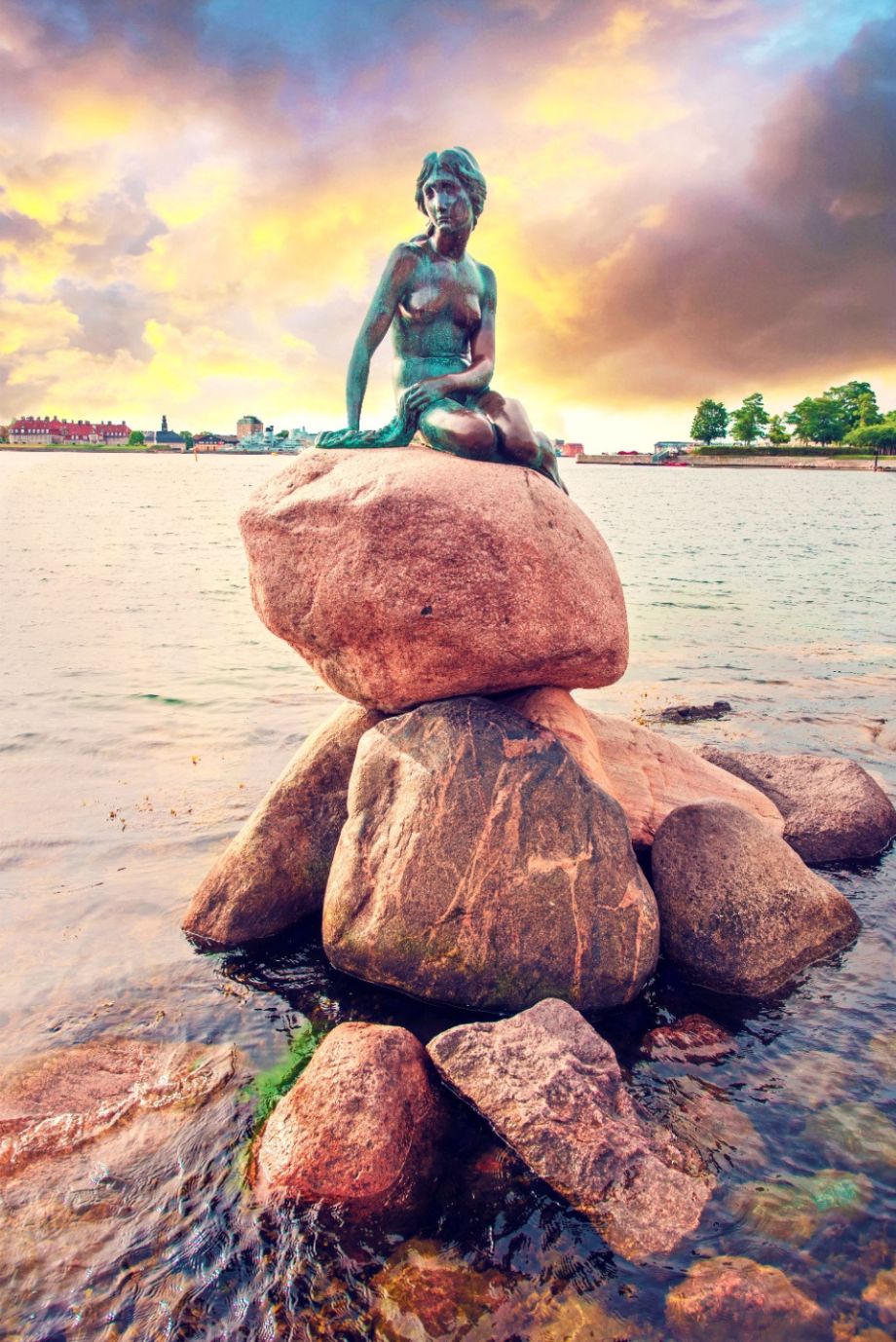Overlooking the Copenhagen harbour, The Little Mermaid statue embodies a timeless tale of love and sacrifice, capturing visitors' hearts and serving as an important symbol of cultural heritage.
While Norway boasts its own rich heritage and stunning landscapes, neighboring Denmark holds an iconic treasure that beckons travellers: Copenhagen's Little Mermaid statue.

This emblem of Danish culture and folklore, perched quietly on the shores of Copenhagen harbour, offers a profound connection to the Scandinavian region's shared myths and artistic traditions.
Introducing the Little Mermaid
For over a century, a small but profoundly significant bronze statue has captivated the hearts of those who visit Copenhagen. Despite its diminutive stature, it has become one of the most famous landmarks of Denmark.
Perched silently on a rock and gazing out towards the horizon, The Little Mermaid statue, crafted by Edvard Eriksen, embodies the enchanting tale of a mermaid yearning for humanity.
Denmark Travel Resources: Things To Do In Copenhagen – Book Hotels – Book Guided Tours of Copenhagen – Car Rental – Travel Insurance
Inspired by Hans Christian Andersen's 1837 fairy tale, this statue not only represents a mermaid's dream to live among humans but also marks a significant cultural landmark in Denmark.
Hans Christian Andersen's tale is a poignant narrative that diverges from typical fairy tales by weaving a story filled with both tragedy and aspirations for a joyous resolution.

This story of a young mermaid, who sacrifices her voice and undergoes immense pain for love and an immortal soul, has moved beyond the pages of literature to become a cultural icon, thanks in part to adaptations like Disney’s 1989 animated film and its live-action remake.
These adaptations have helped ensure that the tale remains beloved across generations worldwide.
The Little Sculpture with the Big Story
Contrasting with more imposing statues like Rio de Janeiro's Christ the Redeemer or the Statue of Liberty in New York, The Little Mermaid statue is modest in size, standing just over four feet tall.
Its small stature often surprises visitors accustomed to grander monuments, but its size belies its enormous cultural significance.
Positioned on a waterfront rock along the Langelinie promenade—a favorite walking area among locals that stretches from the Øresund coast to the Kastellet citadel—the statue is strategically placed close to the DFDS ferry terminal and cruise ship ports.
This placement makes it an accessible highlight for tourists visiting Copenhagen, often resulting in bustling crowds eager to capture a moment with this iconic figure.

The Origins of the Statue
The inception of The Little Mermaid statue was initiated not by Andersen or Eriksen, but by Carl Jacobsen, son of the Carlsberg brewery’s founder.
Jacobsen, a prominent art collector and philanthropist, was so inspired by a ballet adaptation of Andersen’s story that he commissioned the creation of the statue.
Originally, ballerina Ellen Price was to be the model for the mermaid; however, when she hesitated due to the expected public scrutiny, Eriksen modelled the mermaid's face on Price but used his wife's figure for the body.
Since its unveiling in 1913, the statue has only been moved once—remarkably to Shanghai during the Danish Pavilion at Expo 2010, illustrating its international appeal.
A Site of Cultural Expression and Protest
Beyond its allure as a tourist spot, The Little Mermaid statue has also become a focal point for political and social activism. Its high visibility and symbolic value have made it an attractive target for various protests.
The day following the Danish national men's football team's qualification for the 2022 World Cup in Qatar, The Little Mermaid statue became a focal point for human rights activists.
While Danish media and fans rejoiced over the qualification, the sculpture was adorned with a Denmark hat, accompanied by a sign in Danish that starkly read: “15,000 dead in Qatar, hooray for the World Cup.”
This incident is part of a broader history of the statue being used as a platform for various social and political statements.

Over the years, it has been subjected to two decapitations and adorned with messages supporting anti-whaling, veganism, and various international causes including protests related to Iraq, Hong Kong, and Ukraine.
These acts of vandalism highlight its status not just as a cultural icon, but also as a beacon for global advocacy and protest.
Local authorities have debated relocating the statue to protect it from further harm, but it remains in its original, accessible location.
Denmark Travel Resources: Things To Do In Copenhagen – Book Hotels – Book Guided Tours of Copenhagen – Car Rental – Travel Insurance
This decision underscores a commitment to preserving cultural heritage while acknowledging the complex interplay between art and public discourse.
As it stands against the backdrop of the Copenhagen harbour, it remains a beloved symbol of not only Danish heritage but also the universal themes of love, sacrifice, and aspiration that resonate across different cultures and times.
How to Get to the Little Mermaid
The statue is situated just off Langelinie promenade, a 20-minute stroll from Nyhavn along the harbor, passing landmarks like The Royal Danish Playhouse and Amalienborg Palace.
From Copenhagen Central Station, it's three train stops to Østerport Station, then a 15-minute walk by Kastellet's moats to the statue. Alternatively, rent a bike, take a local bus, or use the hop-on hop-off sightseeing bus that stops there.
Another great way to see the sculpture is to join a sightseeing tour of Copenhagen. Rather than battle with the crowds on the shoreline, why not book this classic canal tour?
The two-hour guided cruise along the city's waterways takes in landmarks including Amalienborg Palace, the stunning Copenhagen Opera House, and yes, the Little Mermaid statue.
Another great option is to enjoy the best of the city on two wheels. This two-hour Copenhagen bicycle tour includes 90% of the city's highlights, including the Little Mermaid.

